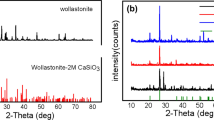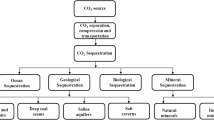Abstract
CO2 mineralization and utilization is a new area for reducing the CO2 emissions. By reacting with natural mineral or industrial waste, CO2 can be transformed into valuable solid carbonate (such as calcium carbonate or magnesium carbonate) with recovery of some products simultaneously. In this paper, a novel method was proposed to mineralize CO2 by means of magnesium chloride with small energy consumption. In this method, magnesium chloride was firstly transformed into magnesium hydroxide by electrolysis. The formed magnesium hydroxide showed high reactivity to mineralize CO2. In our study, even at low concentration, CO2 can be effectively mineralized by this method, which makes it possible to directly mineralize flue gas CO2, avoiding the expensive process of CO2 capture and purification. Moreover, valuable products such as hydromagnesite and nesquehonite can be recovered by this method. Because of the wide distribution of magnesium chloride in nature, large-scale CO2 mineralization is potential by means of magnesium chloride.










Similar content being viewed by others
References
Keith DW (2009) Why capture CO2 from the atmosphere? Science 325:1654–1655
Xie HP (2010) CO2 sequestration and climate change. Sci Technol Rev 3 (in Chinese)
Xie HP (2010) Developing low-carbon technology to promoting green economy. Energy China 32:5–10
Karl TR, Trenberth KE (2003) Modern global climate change. Science 302:1719–1723
Friedlingstein P, Solomon S, Plattner GK et al (2011) Long-term climate implications of twenty-first century options for carbon dioxide emission mitigation. Nat Climate Change 1:457–461
Lackner KS (2003) A guide to CO2 sequestration. Science 300:1677–1678
IPCC (2005) Special report on carbon dioxide capture and storage. Cambridge University Press, Cambridge
Jun YS, Giammar DE, Werth CJ (2013) Impacts of geochemical reactions on geologic carbon sequestration. Environ Sci Technol 47:3–8
Hou MZ, Xie HP, Yoon JS (2010) Underground Storage of CO2 and Energy. CRC Press, Boca Raton
Haszeldine RS (2009) Carbon capture and storage: how green can black be? Science 325:1647–1652
Xie HP (2012) Simultaneous recovery of national resources and mineralization of CO2: A new CCU method. Technical Report, Energy and mining Science, Chinese Academy of Engineering (in Chinese)
Xie HP, Xie LZ, Wang YF et al (2012) Global carbon dioxide emissions should not be CCS, should be CCU method. J Sichuan Univ Eng Sci 44:1–5 (in Chinese)
Xie HP, Wang YF, Ju Y et al (2013) Simultaneous mineralization of CO2 and recovery of soluble potassium using earth-abundant potassium feldspar. Chin Sci Bull 58:128–132
Seifritz W (1990) CO2 disposal by means of silicates. Nature 345:486
Gerdemann SJ, O’Conner WK, Dahlin DC et al (2007) Ex situ aqueous mineral carbonation. Environ Sci Technol 41:2587–2593
Kelemen PB, Matter J (2008) In situ carbonation of peridotite for CO2 storage. Proc Natl Acad Sci USA 105:17295–17300
Koukouzas N, Gemeni V, Ziock HJ (2009) Sequestration of CO2 in magnesium silicates, in Western Macedonia. Greece Int J Miner Process 93:179–186
Loring JS, Thompson CJ, Wang Z et al (2011) In situ infrared spectroscopic study of forsterite carbonation in wet supercritical CO2. Environ Sci Technol 45:6204–6210
Park AHA, Fan LS (2004) CO2 mineral sequestration: physically activated dissolution of serpentine and pH swing process. Chem Eng Sci 59:5241–5247
Fagerlund J, Teir S, Nduagu E et al (2009) Carbonation of magnesium silicate mineral using a pressurised gas/solid process. Energy Procedia 1:4907–4914
Maroto-Valer MM, Fauth DJ, Kuchta ME et al (2005) Activation of magnesium rich minerals as carbonation feedstock materials for CO2 sequestration. Fuel Process Technol 86:1627–1645
Huijgen WJJ, Comans RNJ, Witkamp GJ (2007) Cost evaluation of CO2 sequestration by aqueous mineral carbonation. Energ Convers Manage 48:1923–1935
Huntzinger DN, Gierke JS, Kawatra SK et al (2009) Carbon dioxide sequestration in cement kiln dust through mineral carbonation. Environ Sci Technol 43:1986–1992
Sun J, Bertos MF, Simons SJR (2008) Kinetic study of accelerated carbonation of municipal solid waste incinerator air pollution control residues for sequestration of flue gas CO2. Energy Environ Sci 1:370–377
Huijgen WJJ, Witkamp GJ, Comans RNJ (2005) Mineral CO2 sequestration by steel slag carbonation. Environ Sci Technol 39:9676–9682
Stolaroff JK, Lowry GV, Keith DW (2005) Using CaO- and MgO-rich industrial waste streams for carbon sequestration. Energ Convers Manage 46:687–699
IEA (2011) CO2 emission from fuel combustion highlights. France: OECD/IEA
Faverjon F, Durand G, Rakib M (2006) Regeneration of hydrochloric acid and sodium hydroxide from purified sodium chloride by membrane electrolysis using a hydrogen diffusion anode-membrane assembly. J Membr Sci 284:323–330
Faverjon F, Rakib M, Durand G (2005) Electrochemical study of a hydrogen diffusion anode-membrane assembly for membrane electrolysis. Electrochim Acta 51:386–394
Holze S, Jorissen J, Fischer C et al (1994) Hydrogen consuming anodes for energy saving in sodium sulphate electrolysis. Chem Eng Technol 17:382–389
Jung KS, Keener TC, Green VC et al (2004) CO2 absorption study in a bubble column reactor with Mg(OH)2. Int J Environ Technol and Manage 4:116–136
Cao X, Chen XP (2000) The technology of desulfurization by means of magnesium hydroxide. Nonferrous Metal Eng Res 21:47–51
Rao TR, Chohan VS (1995) Kinetics of thermal decomposition of hydromagnesite. Chem Eng Technol 18:359–363
Hollingbery LA, Hull TR (2010) The thermal decomposition of huntite and hydromagnesite—a review. Thermochim Acta 509:1–11
Acknowledgments
This work was supported by International Cooperative Research Project of the Ministry of Science and Technology (2012DFA60760), the Natural Science Foundation of China (51120145001, 51254002), the National Natural Science Funds for Distinguished Young Scholars (51125017), and the Natural Basic Research Projects of China (2011CB201201, 2010CB226804).
Author information
Authors and Affiliations
Corresponding author
About this article
Cite this article
Xie, H., Wang, Y., Chu, W. et al. Mineralization of flue gas CO2 with coproduction of valuable magnesium carbonate by means of magnesium chloride. Chin. Sci. Bull. 59, 2882–2889 (2014). https://doi.org/10.1007/s11434-014-0388-1
Received:
Accepted:
Published:
Issue Date:
DOI: https://doi.org/10.1007/s11434-014-0388-1




